The LNRS viewer allows you to explore the spatial priorities and opportunities identified in the Devon Local Nature Recovery Strategy (see Where to focus action on the habitats and species pages).
Groups of layers on the viewer and overview maps
These layers show all statutory and non-statutory wildlife sites as well as statutory irreplaceable habitats.
It’s a statutory requirement to include this layer in the LNRS’s Local Habitat Map. The Environment Act refers to this layer as ‘Areas of Particular Importance for Biodiversity’.
The map below is a clip from the viewer showing all statutory and non-statutory site layers opened (for OS copyright please see the viewer).
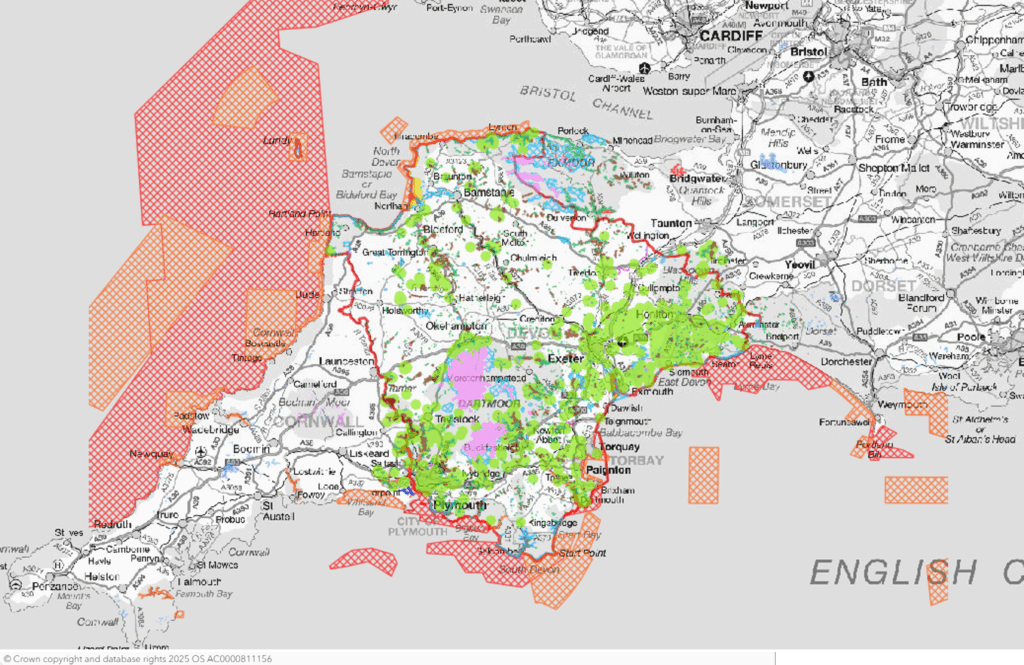
© Crown copyright and database rights 2025 OS AC0000811156
These are areas where actions to manage, restore and create habitats are most needed.
It’s a statutory requirement to include this layer in the Local Habitat Map. Statutory guidance and information relating to Biodiversity Net Gain refers to this as the ‘mapped measures’ layer.
The maps below are clips from the viewer showing examples of High Opportunity Area layers (for OS copyright please see the viewer).
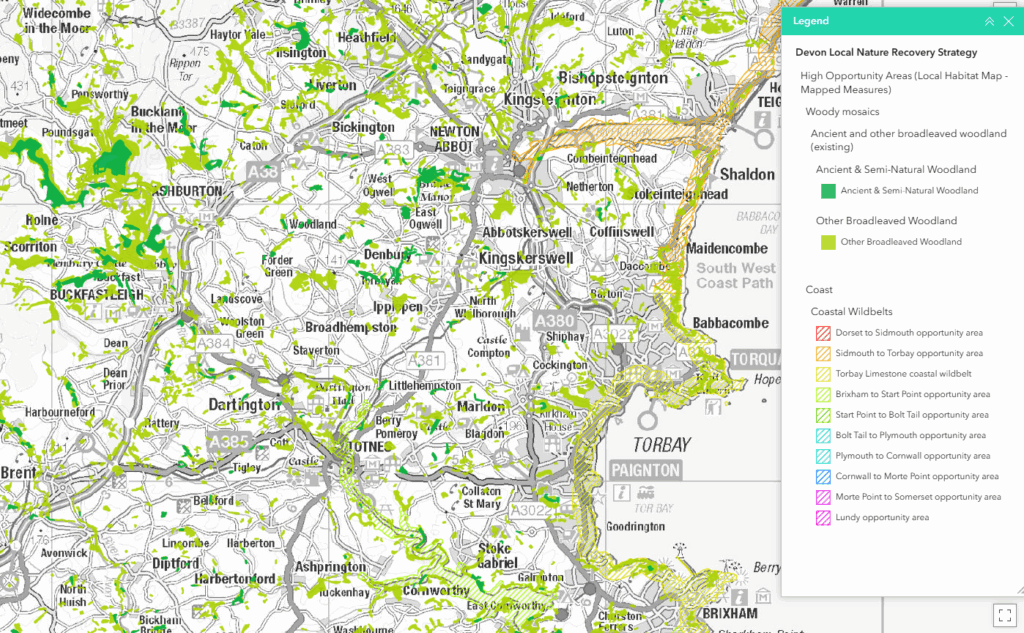
© Crown copyright and database rights 2025 OS AC0000811156
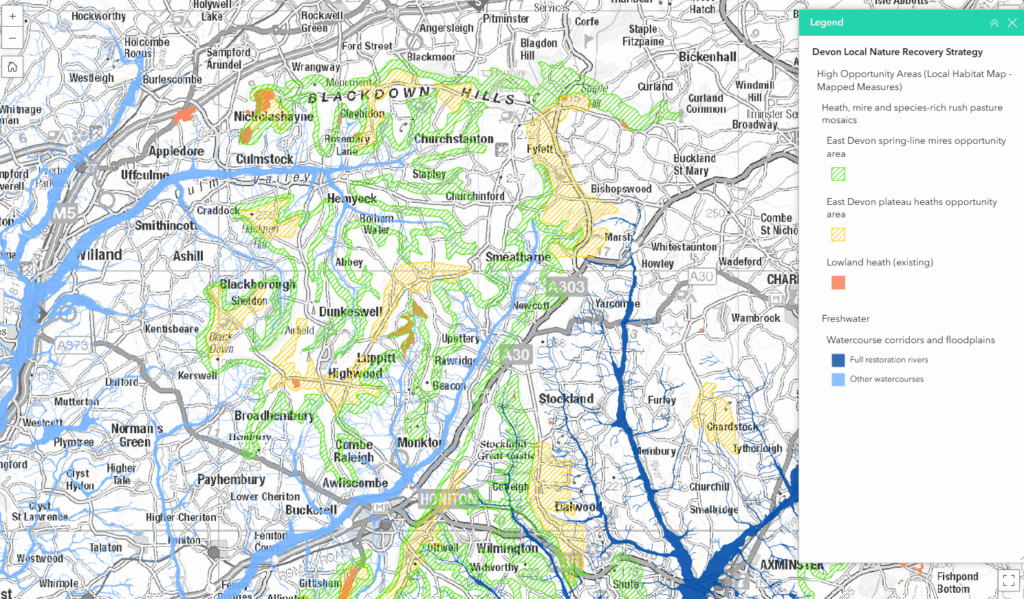
© Crown copyright and database rights 2025 OS AC0000811156
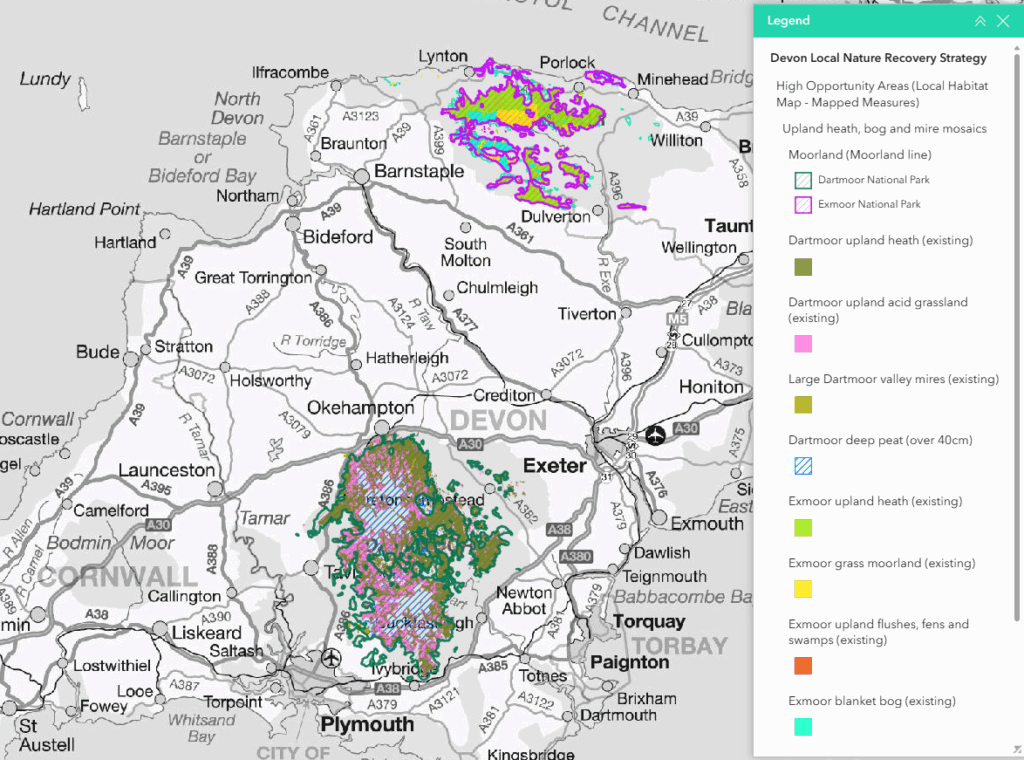
© Crown copyright and database rights 2025 OS AC0000811156
These layers show areas where landscape-scale action is required for the more mobile Devon Special Species (bats, birds, butterflies). There are also a few more focused areas mapped, such as for the Teign Valley spiders.
Because these layers are generally large landscapes, they are not included in the statutory Local Habitat Map which requires focused mapping. The actions relating to species are part of the statutory LNRS, see Species.
The maps below are clips from the viewer showing examples of Species Opportunity Area layers (for OS copyright please see the viewer).
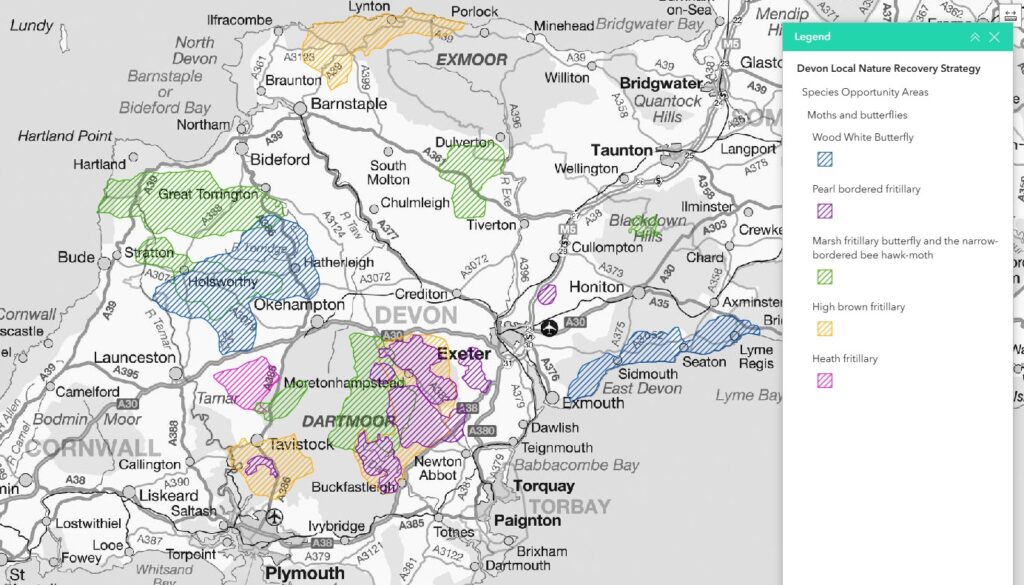
© Crown copyright and database rights 2025 OS AC0000811156
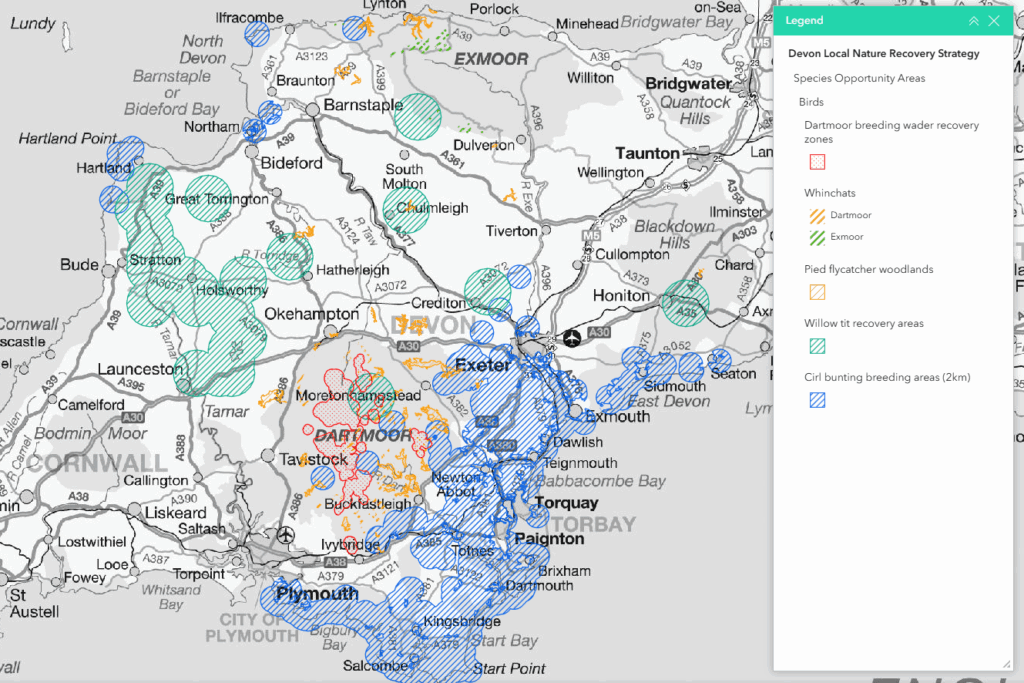
© Crown copyright and database rights 2025 OS AC0000811156
Water quality and flood risk opportunity areas:
- These layers have been provided through discussion with the Environment Agency and South West Water to show where wildlife habitats are most needed to help meet priorities relating to water quality and flood risk. See the Water quality and flood risk page.
Community access to nature opportunity areas:
- These layers are simple 500m zones around all community centres and non-private schools. They simply show where creating and managing wildlife-rich accessible green space could be most beneficial for communities. See the Connecting people and nature page.
These layers are not part of the statutory LNRS (part of the local habitats map) and are included to for guidance. All actions are however part of the the statutory LNRS – see the Water page.
The map below is a clip from the viewer showing natural flood management high priority catchments (for OS copyright please see the viewer).
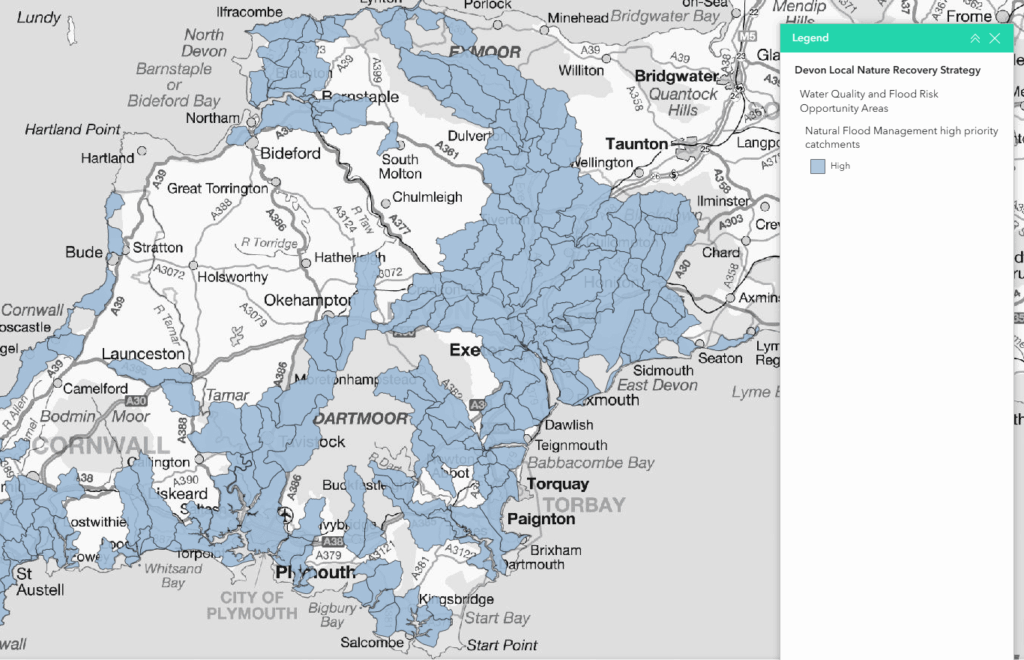
© Crown copyright and database rights 2025 OS AC0000811156
Opportunity for Nature Everywhere
Wherever you are in Devon, there are actions you can take to help restore wildlife. See the most relevant habitat or species page on this website.
Other Useful Layers
These are additional layers that provide important context and help guide broader nature recovery actions. They include soilscapes, agricultural land classification, common land, protected landscapes, landscape character and more.
Devon LNRS boundary
Defined by Defra.
The map below is a clip from the viewer showing Soilscapes (for copyright please see the viewer).
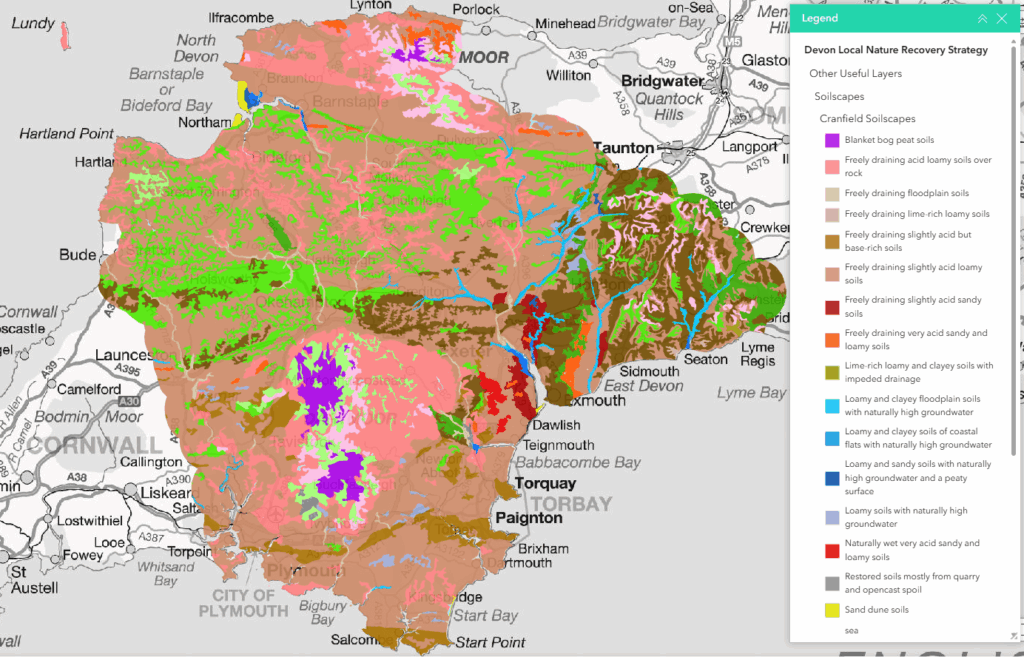
© Crown copyright and database rights 2025 OS AC0000811156
PLEASE watch the video or read the instructions below before using the Viewer, even if you’ve used them before. The instructions include critical information on how to open layers and how to open the layers in your area of interest using the ‘Near Me’ function. Please be patient as the Viewer can sometimes be slow to load larger layers.
The Viewer does not currently work on mobile phones. Users will be able to download the majority of the GIS layers but this function is not available for the draft LNRS.
Devon Nature Recovery Delivery Map
We’d love to hear how you’re helping nature thrive! Whether you’re planting trees, restoring habitats, reducing waste, or supporting local wildlife, add your contribution to the LNRS Viewer and inspire others to take action.
All submissions will be reviewed before they appear on the Viewer. This ensures that every entry is appropriate and meaningful. As a result, there may be a short delay before your submission becomes visible.
A Mapping Paper sets out how each layer has been mapped and includes health warnings about the accuracy of specific layers. This paper also sets out who to contact in national organisations to submit updates to the owner of the data. For example, contact Natural England to add an update to the National Priority Habitat Inventory layers.
Health warning on the accuracy of the mapping: Land use, land management and species distributions across Devon are constantly changing, so mapping can never be perfect. Therefore, the mapping in the LNRS is just a guide. Any land use decisions relating to wildlife must be based on knowledge of soils, existing habitats, species present and habitats and species in the surrounding area. Obtaining ecological advice is always recommended.
How to use the Viewer
Please accept the Terms and Conditions when opening the LNRS Viewer so you can proceed.
How to open layers:
Option 1
Positioned on the left side of the viewer, the Layers function (or menu) allows you to switch on (and switch off) map layers. If you can’t see it, use the ‘ > ‘ symbol in the white box on the left side of the screen to expand it.
Click on the ‘ > ‘ icon next to Local Nature Recovery Strategy to show the seven main Layer Groups in the menu (as explained in the drop-downs above). The > icon sits next to the heading for a group of layers (so is not a layer you can view). Tick the box next to the heading (so that it’s green) and then tick the box next to the layers that you want to open.
IMPORTANT: To view a specific layer on the map you must tick (enable) the layer itself and ALL parents group headings above it . For example, for SSSIs to open on the map the following green ticks must be switched on: Devon Local Nature Recovery Strategy > Designated sites and statutory irreplaceable habitats > Statutory designations > Sites of special scientific interest.
- ✅ Green tick = switched on
- ⬜ Empty box = switched off
You can see which layers have opened on the Viewer by looking at the legend (on the top-right of the screen).
You can choose to view several layers at a time. Layers higher up the list will appear over the top of layers lower down the list. You may have to switch off some higher layers to see some lower layers. Layers are not shown in priority order. Layers may also take time to load, particularly if they are large (data-rich) or if your broadband speed is low.
Option 2
The Near Me tool allows you to find and explore layers within a specified distance of a selected point or within a polygon that you have drawn on the map.
- Open the Near Me tool
- Click the Near Me icon in the top-right toolbar.
- Select drawing tool
- Option A
- Choose Point.
- Choose searchable distance.
- Choose a location by clicking anywhere on the map or drag and drop your point onto the map. This will search for features or data layers within the set distance from that point.
- Option B
- Choose Polygon.
- Use the polygon tool to draw a shape on the map.
- Double click on the last node to draw your shape.
- Option A
- View results
- A list of high opportunity areas within the search area will appear in the right-hand panel.
- Click on any item to see more details or zoom to its location.
- Bin
- Click on the trash can symbol to clear your selection.
Pop-up Information
Once you have opened a layer, click anywhere on that layer to see more information.
A pop-up will appear showing the data source, a description of the layer features, key recommended actions for that location and important notes about environmental sensitivities.
Click on a link within the pop-up and it will take you to the relevant webpage on the LNRS website.
Useful tools
Home
![]()
Click on the home icon to reset the map to its full extent.
Zoom
![]()
Use your mouse scroll wheel or the zoom buttons (+/-) to zoom in and out. Click and drag to move around the map.
1. Print
If you’d like to save or share a map view, use the Print tool.
Click the printer icon, adjust the settings if you wish, and then click ‘Print’.
You can download or print a PDF or image of your current map view.
2. Measure
The Measurement tool lets you measure distances or areas on the map.
Click the ruler icon, choose whether you want to measure a line or an area, then click on the map to start measuring.
Double-click to finish and see the result.
Click on ‘clear measurement’ to remove your latest result.
3. Search
To quickly find a place, use the Search tool at the top of the map.
Type in a place name, postcode or address and the map will zoom to that spot.
You can also filter your search with one of the set options, such as Devon Wildlife Trust Nature Reserves.
4. Legend
Click on the Legend icon to understand what the colours and symbols mean for each layer.
This is a good way to check whether you have correctly switched on the right layers.
5. Basemap Gallery
If you’d like to change the background map, use the Basemap Gallery.
